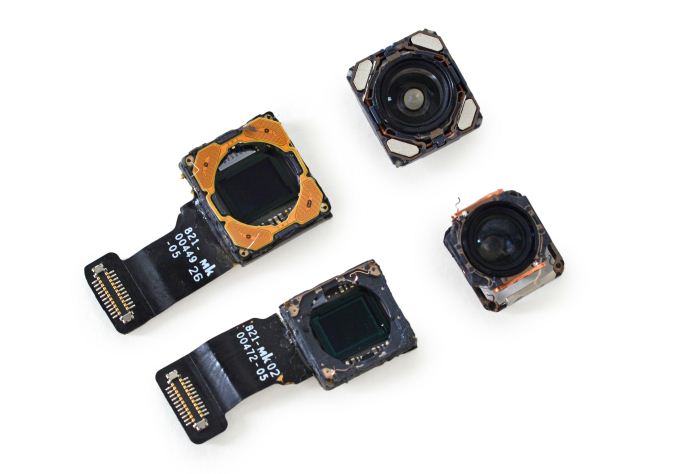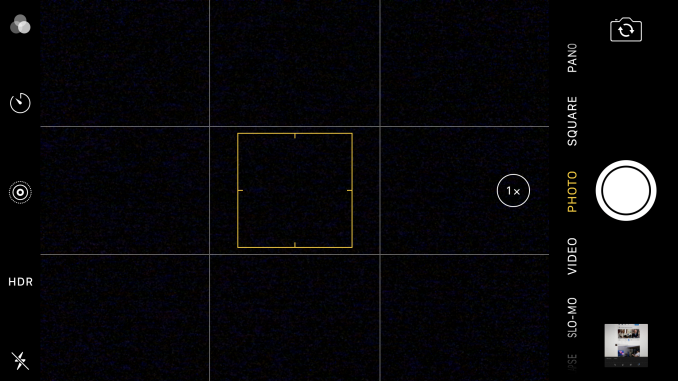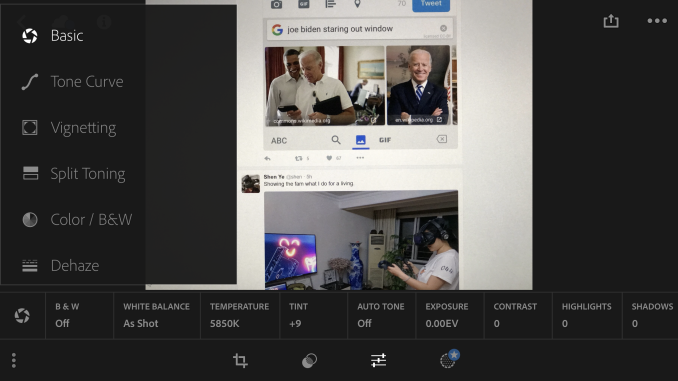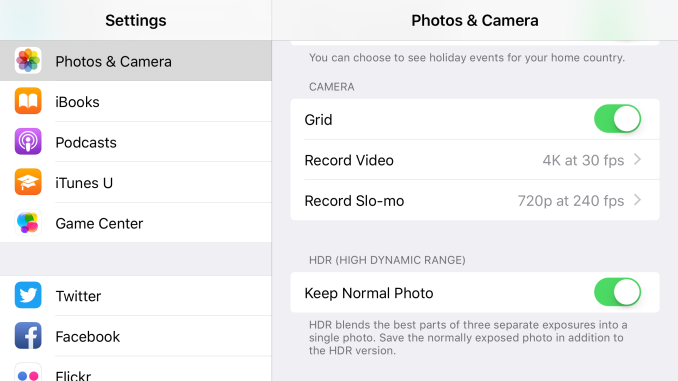The iPhone 7 and iPhone 7 Plus Review: Iterating on a Flagship
by Joshua Ho & Brandon Chester on October 10, 2016 8:00 AM EST- Posted in
- Smartphones
- Apple
- Mobile
- iOS
- iOS 10
- iPhone 7
- iPhone 7 Plus
Camera Architecture
Before we get into the results of the camera output it's always helpful to actually examine the basic characteristics and hardware that make up the camera as a number of characteristics can be predicted or understood by looking at the basic hardware. The CIS technology used can have significant impacts on noise, active area, and a number of other features including slow motion video capture. However, to say that the CIS is the only area worth examination ignores the whole chain of hardware and software needed to make a great camera. With that said we can start our look at the camera with the table below which summarizes a number of high level details for the camera.
| Apple iPhone Cameras | ||||
| Apple iPhone 6s Apple iPhone 6s Plus |
Apple iPhone 7 Apple iPhone 7 Plus |
|||
| Front Camera | 5.0MP | 7MP | ||
| Front Camera - Sensor | Sony ? (1.12 µm, 1/5") |
Sony Exmor RS (1.0 µm, 1/?") |
||
| Front Camera - Focal Length | 2.65mm (31mm eff) | 2.87mm (32mm eff) | ||
| Front Camera - Max Aperture | F/2.2 | F/2.2 | ||
| Rear Camera | 12MP | 12MP | ||
| Rear Camera - Sensor | Sony Exmor RS (1.22 µm, 1/3") |
Sony Exmor RS (1.22 µm, 1/3") |
||
| Rear Camera - Focal Length | 4.15mm (29mm eff) | 4mm (28mm eff) 8mm (56mm eff) Secondary |
||
| Rear Camera - Max Aperture | F/2.2 | F/1.8 F/2.8 Secondary |
||
Looking at the camera of the iPhone 7 in some ways the cadence has changed up a bit. While the iPhone 5s to iPhone 6 transition saw the use of almost identical camera sensor and optics, the iPhone 7 actually changes things up relative to the camera that we saw in the iPhone 6s, likely because the difference between the iPhone 6 and 6s camera was fairly mild in still photos. The iPhone 7 still appears to use a similar sensor on the rear, but with a new set of optics that incorporates a wider aperture. Apple seems to be fighting against serious z-height limitations, so we’re continuing to see a reduction in focal length as the iPhone 7 is now basically comparable to phones like the One M7 with its 28mm equivalent focal length. It’d be interesting to know transmission efficiency which would allow for proper comparisons between generations but considering how most dSLR lenses don't' list these specs it's not a surprise that we don't see this kind of disclosure.

iPhone 7 Plus's dual camera modules (Image Courtesy iFixit)
What isn’t listed on the spec sheet is that the iPhone 7 now has OIS, which is going to be a serious step up in terms of performance for anyone upgrading from the iPhone 6 or 6s. While Apple has some proprietary EIS that allows for really impressive performance despite the lack of OIS, a physical mechanism to compensate for hand shake is going to make for a more effective system in the first place, as it fixes the problem before the photons are captured. Apple continues to use advanced software to enable long exposure without visible blur or hand shake so the addition of OIS shouldn’t have any noticeable drawbacks other than increased shot latency in low light.
Of course, the iPhone 6s Plus already had OIS, so for the iPhone 7 Plus there is a new secondary camera with a focal length that is twice as long as the primary camera. However, the aperture is smaller, which means that in low light the system is going to automatically fall back to the primary camera which is still better in low light as far as I can tell, especially because the second camera lacks OIS. However, in bright daytime conditions the second camera’s longer focal length allows for better portraits and better detail in general. This helps to compensate for the iPhone’s sensor size and z-height limitations, but can only really help in daytime conditions.
Interestingly enough, Apple is actually one of the first OEMs to my knowledge to adopt a 1 micron pixel pitch for a camera sensor, but this is being done for the front-facing camera. I’m kind of curious to know what led to this decision as the optics are probably not going to be able to resolve such a small pixel size. We generally don’t review front-facing cameras but for the people that care about this sort of thing I suspect that the FFC is mostly a sidegrade in the sense that it’s probably going to be used to enable higher resolution video capture rather than higher quality still photos.
Camera UX
As far as the camera application goes, there’s really nothing new this generation. If you’ve taken pictures with a relatively new iPhone, you’re going to be right at home with the iPhone 7’s camera UI. For those that haven’t used a relatively new iPhone before we can do a quick review to discuss what is and isn’t present. At a high level, the UI is split up into a few logical sections, with mode-specific options in their own section. Modal selection is on the opposite side, with text that fairly clearly delineates the purpose of each mode. Below the modal selection, general options are presented for things like changing between front and rear cameras as well as the shutter button and camera roll.
It's hard to really say much about the iPhone camera UI at this point because it’s been polished to the point that there’s really no obvious criticisms to make about it. Apple may have made the mistake of shipping a 16:9 preview for a 4:3 camera before, but it’s been years since glaring issues like that have come up. Tapping to focus allows for either locking focus and exposure or biasing the exposure, which is going to provide coverage for 95% of still image cases. Of course, if you want more fine adjustment the default camera app is going to be inadequate, but there are plenty of good manual camera applications on the market like ProCam, ProShot, and Manual Camera.
It’s worth mentioning that while Apple was far from first to implement RAW capture on smartphones, their implementation is differentiated by a real end to end solution. Something like the HTC 10 really needs Lightroom to bring out the best in its RAW captures, although Snapseed is still reasonably useful in a pinch. Apple is leveraging their ecosystem which allows for things like fully featured Adobe Lightroom for RAW processing. I thought for a very long time that processing RAW was infeasible in the context of a smartphone TDP without fixed-function hardware, so it’s incredibly impressive to see Lightroom working smoothly when processing RAW images.
While most of the camera UX is designed well, one noticeable issue here is that the camera settings are integrated into the settings application rather than the camera application itself. If you’re used to how iOS works this makes sense, but things like resolution settings for video are placed in this menu rather than integrated into the camera application which makes switching between these settings relatively painful if you’re used to something like the HTC 10’s camera UI which places resolution settings in a slide-out drawer. This isn't a huge issue but it's definitely something I noticed due to the need to rapidly switch between resolution settings for video testing. Your mileage may vary here if you don't particularly care for such issues. Overall though, the camera UX has few friction points.













377 Comments
View All Comments
lolipopman - Tuesday, October 11, 2016 - link
I agree that Apple rules the market currently.*Currently*. It actually seems that the recently announced ARM A73 will be a beast.
And let's not forget the Mali G71 which is said to be very close to Nvidia Shield's performance.
I'm curious what the A11 chip will be bringing to the graphics table when the next revision of iPhones drop.
jospoortvliet - Tuesday, October 11, 2016 - link
Sadly the A73 won't even make a dent, it is maybe 20% faster at same power, that isn't a third of the gap with Apple...GPUs are doing better indeed but with far higher pixel densities end user experience is still that much worse.
tuxRoller - Tuesday, October 11, 2016 - link
Unfortunately it won't. The a73 looks to be quite good at efficiency, but per clock perf is still going to be decently far behind.As for graphics, no one can match IMG for efficiency. I really wish arm/Softbank would buy IMG.
ex2bot - Wednesday, October 12, 2016 - link
Android has been competitive in many areas and just plain better in some important ones (customization, screen quality, flexibility, choice), but the truth is that Qualcomm fell behind in perf with the 810 and 820. It looks like the 821 is close in performance.Secondly, the 7 and 7 Plus are most likely going to show better battery life because they have bigger batteries than the 6s and 6S Plus.
CloudWiz - Thursday, October 13, 2016 - link
821 is just a clocked-bumped 820, the performance difference between 820 and 821 will be less than 10%. Kryo is currently twice as slow as Hurricane in ST and far less efficient.cknobman - Monday, October 10, 2016 - link
I'm just going to reference this: http://www.windowscentral.com/best-smartphone-came...This was a blind test of over 13000 people voting on pictures taken in many many different scenarios. It compared 4 of the top smartphone cameras (which one of which was the iPhone 7).
The Galaxy S7 won by a landslide, not even close.
The iPhone 7 has its own drawbacks largely ignored by this review.
The lack of a headphone jack is a bigger issue that anyone makes it out to be and iOS is a terribly hindered OS that makes using any iPhone an painful experience.
Sure the battery life is good/great but this is largely because Apple choosing to remain so far back in their resolution. If you live in a Apple box and only look at their devices then sure its fine.
But go use any of the dozens of non Apple phones out there and then come back to an iPhone (especially the plus) and you immediately notice the lowered resolution and display quality.
The Garden Variety - Monday, October 10, 2016 - link
I was in tears and the injustice of this "review" until I read your supportive, nurturing reply. Thank you for giving all of us hope. Hope that the truth will reign, and that someday tech "journalists" will be exposed and jailed for their obvious bias. JAILED.cknobman - Monday, October 10, 2016 - link
LOL Your butthurt was so painful it seems you could not even comprehend what I wrote.I never called out the reviewer for bias or injustice but you apparently only choose to read/see/envision what you want...............either that or you are just plain stupid.
grayson_carr - Monday, October 10, 2016 - link
Let me propose a scenario. You have two identical displays. One is perfectly calibrated. One has the color saturation boosted and does not display colors accurately. If you pull a bunch of people off the street and have them look at both displays and vote on which one looks better, which one do you think they are going to pick? Answer: They are going to say the one with boosted saturation is better despite it being an identical display with objectively worse calibration. The average person does not know what is good, which is why I think blind photo comparisons are stupid. Now I'm not saying the Galaxy S7 doesn't have the best camera in a phone. The Galaxy S7 probably does have the best camera in a phone (in stills at least, video sucks). But I would much rather hear it from a professional photographer than a bunch of average Joes that know nothing about photography or cameras. That's just me.menting - Monday, October 10, 2016 - link
a professional photographer will probably feel insulted to even consider a rating a photo from a phone.